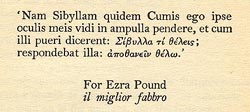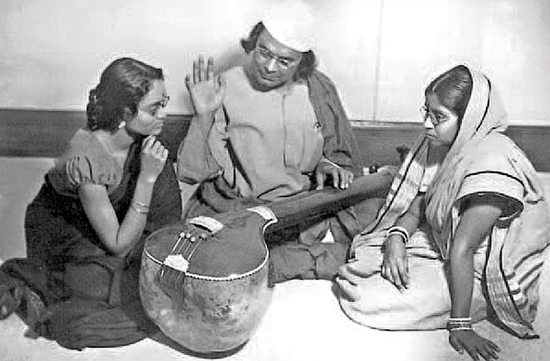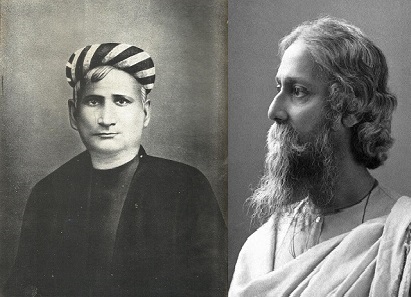|
1922 In Poetry
— Opening lines from ''The Waste Land'' by T. S. Eliot, first published this year Nationality words link to articles with information on the nation's poetry or literature (for instance, Irish or France). Events * February 2 ** ''Who Goes with Fergus?'' by W. B. Yeats (first published in 1892) is the song that haunts James Joyce's autobiographical character Stephen Dedalus in the novel '' Ulysses'', first published complete in book form today. Stephen sings it to his mother as she lies dying, and her ghost returns to taunt him with it. The poem is Joyce's favorite lyric, and he has composed his own musical setting. ** In a "savage creative storm" of less than three weeks beginning today at the Château de Muzot in Switzerland, Rainer Maria Rilke writes his ''Sonnets to Orpheus'' (''Die Sonette an Orpheus'') and completes his ''Duino Elegies'' (''Duineser Elegien''). * April – ''The Fugitive'' is established in Nashville, Tennessee, by John Crowe Ransom and other memb ... [...More Info...] [...Related Items...] OR: [Wikipedia] [Google] [Baidu] |
The Waste Land
''The Waste Land'' is a poem by T. S. Eliot, widely regarded as one of the most important poems of the 20th century and a central work of modernist poetry. Published in 1922, the 434-line poem first appeared in the United Kingdom in the October issue of Eliot's ''The Criterion'' and in the United States in the November issue of ''The Dial''. It was published in book form in December 1922. Among its famous phrases are "April is the cruellest month", "I will show you fear in a handful of dust", and the Sanskrit mantra " Shantih shantih shantih". Eliot's poem combines the legend of the Holy Grail and the Fisher King with vignettes of contemporary British society. Eliot employs many literary and cultural allusions from the Western canon such as Ovid's Metamorphoses and Dante's ''Divine Comedy'', as well as Shakespeare, Buddhism, and the Hindu Upanishads. The poem shifts between voices of satire and prophecy featuring abrupt and unannounced changes of speaker, location, and time a ... [...More Info...] [...Related Items...] OR: [Wikipedia] [Google] [Baidu] |
Stopping By Woods On A Snowy Evening
"Stopping by Woods on a Snowy Evening" is a poem by Robert Frost, written in 1922, and published in 1923 in his ''New Hampshire'' volume. Imagery, personification, and repetition are prominent in the work. In a letter to Louis Untermeyer, Frost called it "my best bid for remembrance". Analysis The text of the poem reflects the thoughts of a lone wagon driver (the narrator), pausing at dusk in his travel to watch snow falling in the woods. It ends with him reminding himself that, despite the loveliness of the view, "I have promises to keep, / And miles to go before I sleep." Background Frost wrote the poem in June 1922 at his house in Shaftsbury, Vermont. He had been up the entire night writing the long poem "New Hampshire" from the poetry collection of the same name, and had finally finished when he realized morning had come. He went out to view the sunrise and suddenly got the idea for "Stopping by Woods on a Snowy Evening". He wrote the new poem "about the snowy evening a ... [...More Info...] [...Related Items...] OR: [Wikipedia] [Google] [Baidu] |
Bengal Presidency
The Bengal Presidency, officially the Presidency of Fort William and later Bengal Province, was a subdivision of the British Empire in India. At the height of its territorial jurisdiction, it covered large parts of what is now South Asia and Southeast Asia. Bengal proper covered the ethno-linguistic region of Bengal (present-day Bangladesh and the Indian state of West Bengal). Calcutta, the city which grew around Fort William, was the capital of the Bengal Presidency. For many years, the Governor of Bengal was concurrently the Viceroy of India and Calcutta was the de facto capital of India until 1911. The Bengal Presidency emerged from trading posts established in Mughal Bengal during the reign of Emperor Jahangir in 1612. The East India Company (HEIC), a British monopoly with a Royal Charter, competed with other European companies to gain influence in Bengal. After the decisive overthrow of the Nawab of Bengal in 1757 and the Battle of Buxar in 1764, the HEIC expan ... [...More Info...] [...Related Items...] OR: [Wikipedia] [Google] [Baidu] |
Dhumketu (magazine)
''Dhumketu'' ( ''dhūmkētu'', "comet") was a bi-weekly magazine edited by Kazi Nazrul Islam which was first published on 11 August 1922. The magazine was started with a four-page format, later elaborated to eight pages. The last issue of the magazine was published in March 1923. Many of the popular poems of Nazrul including ''Anandamoyeer Agamane, Dhumketu ''etc.'' ''were published in this magazine. Sarat Chandra Chattopadhyay also contributed to the magazine. Editorial Board Kazi Nazrul Islam edited several special issues of the magazine including the ''Muharram'' issue in August 1922, the ''Agamani'' issue on 26 September 1922, ''Puja'' Issue on 22 September 1922, the ''Diwali ''issue on 20 October 1922 and the ''Congress'' issue on 27 December 1922. While Nazrul was in jail, Biren Sen Gupta and Amaresh Kanji Lal edited the magazine. Anti-British publication In the ''Puja'' Issue of the ''Dhumketu'' magazine published on 22 September 1922, Nazrul wrote an British Raj, anti-B ... [...More Info...] [...Related Items...] OR: [Wikipedia] [Google] [Baidu] |
Indian Independence Movement
The Indian independence movement was a series of historic events with the ultimate aim of ending British Raj, British rule in India. It lasted from 1857 to 1947. The first nationalistic revolutionary movement for Indian independence emerged from Bengal. It later took root in the newly formed Indian National Congress with prominent moderate leaders seeking the right to appear for Indian Civil Service (British India), Indian Civil Service examinations in British India, as well as more economic rights for natives. The first half of the 20th century saw a more radical approach towards self-rule by the Lal Bal Pal, Lal Bal Pal triumvirate, Aurobindo Ghosh and V. O. Chidambaram Pillai. The final stages of the independence struggle from the 1920s was characterized by Congress' adoption of Mahatma Gandhi's policy of non-violence and Salt March, civil disobedience. Intellectuals such as Rabindranath Tagore, Subramania Bharati, and Bankim Chandra Chattopadhyay spread patriotic awarenes ... [...More Info...] [...Related Items...] OR: [Wikipedia] [Google] [Baidu] |
Kazi Nazrul Islam
, pseudonym = bn, ধূমকেতু, Dhūmketu , image = Nazrul.jpg , image_size = , caption = Nazrul in Chittagong, 1926 , birth_date = 11 ''Joiṣṭhyô'', 1306 '' Bônggabdô'' , birth_place = Churulia, Asansol, Bengal Presidency, British India , death_date = , death_place = Dhaka, Bangladesh , resting_place = Mausoleum of Kazi Nazrul Islam , occupation = , language = , citizenship = British Indian Indian Bangladeshi , education = , alma_mater = , period = 1922–1942 , genre = , subject = , movement = Bengali Renaissance , notableworks = , spouse = , children = , awards = , signature = Signature of Kazi Nazrul.jpg , signature_alt = , module = , party = Workers ... [...More Info...] [...Related Items...] OR: [Wikipedia] [Google] [Baidu] |
Bengali Poetry
Bengali poetry is a rich tradition of poetry in the Bengali language and has many different forms. Originating in the Bengal region of South Asia, the history of Bengali poetry underwent three successive stages of development: poetry of the early age (like '' Charyapad''), the Medieval period and the age of modern poetry. All ages have seen different forms of poetry and poetical tradition. It reached the pinnacle during the Bengali Renaissance period although it has a rich tradition and has grown independent of the movement. Major Bengali Poets throughout the ages are Chandidas, Alaol, Ramprasad Sen, Michael Madhusudan Dutt, Nabinchandra Sen, Rabindranath Tagore, Dwijendralal Ray, Satyendranath Dutta, Kazi Nazrul Islam, Jibanananda Das, Jasimuddin, Sukanta Battacharya, Al Mahmud. Introduction Poetry in the colloquial dialect of Bengal first originated from Prakrit, and based upon local socio-cultural traditions. It was antagonistic towards Vedic rituals and laws as oppo ... [...More Info...] [...Related Items...] OR: [Wikipedia] [Google] [Baidu] |
Indian Poetry
Indian poetry and Indian literature in general, has a long history dating back to Vedic times. They were written in various Indian languages such as Vedic Sanskrit, Classical Sanskrit, Tamil, Odia, Maithili, Telugu, Kannada, Bengali, Assamese, Urdu, and Hindi. Poetry in foreign languages such as English also has a strong influence on Indian poetry. The poetry reflects diverse spiritual traditions within India. In particular, many Indian poets have been inspired by mystical experiences. Poetry is the oldest form of literature and has a rich written and oral tradition. Indian poetry awards There are very few literary awards in India for poetry alone. The prestigious awards like Jnanapeeth, Sahitya Akademi and Kalidas Samman etc. are given away to writers of both prose and poetry. Most of the awards have gone to novelists. Few poets have received these awards. Jnanpith Award The following poets have won the Jnanpith award for their poetry: Firaq Gorakhpuri for his ''Gul-e-Na ... [...More Info...] [...Related Items...] OR: [Wikipedia] [Google] [Baidu] |
Aesthete
Aestheticism (also the Aesthetic movement) was an art movement in the late 19th century which privileged the aesthetic value of literature, music and the arts over their socio-political functions. According to Aestheticism, art should be produced to be beautiful, rather than to serve a moral, allegorical, or other didactic purpose, a sentiment exemplified by the slogan "art for art's sake." Aestheticism originated in 1860s England with a radical group of artists and designers, including William Morris and Dante Gabriel Rossetti. It flourished in the 1870s and 1880s, gaining prominence and the support of notable writers such as Walter Pater and Oscar Wilde. Aestheticism challenged the values of mainstream Victorian culture, as many Victorians believed that literature and art fulfilled important ethical roles. Writing in '' The Guardian'', Fiona McCarthy states that "the aesthetic movement stood in stark and sometimes shocking contrast to the crass materialism of Britain ... [...More Info...] [...Related Items...] OR: [Wikipedia] [Google] [Baidu] |
Homosexual
Homosexuality is romantic attraction, sexual attraction, or sexual behavior between members of the same sex or gender. As a sexual orientation, homosexuality is "an enduring pattern of emotional, romantic, and/or sexual attractions" to people of the same sex. It "also refers to a person's sense of identity based on those attractions, related behaviors, and membership in a community of others who share those attractions." Along with bisexuality and heterosexuality, homosexuality is one of the three main categories of sexual orientation within the heterosexual–homosexual continuum. Scientists do not yet know the exact cause of sexual orientation, but they theorize that it is caused by a complex interplay of genetic, hormonal, and environmental influences and do not view it as a choice. Although no single theory on the cause of sexual orientation has yet gained widespread support, scientists favor biologically based theories. There is considerably more evidence support ... [...More Info...] [...Related Items...] OR: [Wikipedia] [Google] [Baidu] |
Fernando Pessoa
Fernando António Nogueira Pessoa (; 13 June 1888 – 30 November 1935) was a Portuguese poet, writer, literary critic, translator, publisher, and philosopher, described as one of the most significant literary figures of the 20th century and one of the greatest poets in the Portuguese language. He also wrote in and translated from English and French. Pessoa was a prolific writer, and not only under his own name, for he created approximately seventy-five others, of which three stand out, Alberto Caeiro, Álvaro de Campos, and Ricardo Reis. He did not call them ''pseudonyms'' because he felt that this did not capture their true independent intellectual life and instead called them ''heteronyms''. These imaginary figures sometimes held unpopular or extreme views. Early life Pessoa was born in Lisbon on 13 June 1888. When Pessoa was five, his father, Joaquim de Seabra Pessôa, died of tuberculosis and on 2 January of the following year, his younger brother Jorge, aged one, ... [...More Info...] [...Related Items...] OR: [Wikipedia] [Google] [Baidu] |
Portuguese Poetry
Portuguese poetry refers to diverse kinds of poetic writings produced in Portuguese. The article covers historical accounts of poetry from other countries where Portuguese or variations of the language are spoken. The article covers Portuguese poetry produced from the Middle Ages (12th century) to the present era. (21st Century.) History Middle Ages The beginnings of Portuguese poetry go back to the early 12th century, around the time when the County of Portugal separated from the medieval Kingdom of Galicia in the northwest of the Iberian Peninsula. It was in this region that the ancestral language of both modern Portuguese and modern Galician, known today as Galician-Portuguese, was the common language of the people. Like the troubadour culture in the Iberian Peninsula and the rest of Europe, Galician-Portuguese poets sang the love for a woman, which often turned into personal insults, as she had hurt her lover's pride. However, this region produced a specific type of song, k ... [...More Info...] [...Related Items...] OR: [Wikipedia] [Google] [Baidu] |







